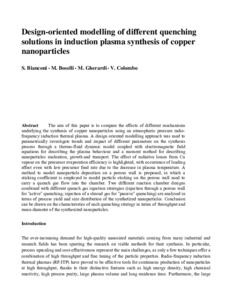Bianconi, Simone ; Boselli, Marco ; Colombo, Vittorio ; Gherardi, Matteo
(2017)
Design-oriented modelling of different quenching solutions in induction plasma synthesis of copper nanoparticles.
Plasma Chemistry and Plasma Processing, 37
(3).
pp. 717-738.
ISSN 1572-8986
Full text disponibile come:
![[thumbnail of Author's Accepted Manuscript]](https://amsacta.unibo.it/5815/1.hassmallThumbnailVersion/AAMM-PCPP-INSPIRED.pdf)  Anteprima |
Documento di testo(pdf) (Author's Accepted Manuscript)
Licenza: Salvo eventuali più ampie autorizzazioni dell'autore, il contributo può essere liberamente consultato e può essere effettuato il salvataggio e la stampa di una copia per fini strettamente personali di studio, di ricerca e di insegnamento, con espresso divieto di qualunque utilizzo direttamente o indirettamente commerciale. Ogni altro diritto sul materiale è riservato.
Download (1MB)
| Anteprima
|
Abstract
The aim of this paper is to compare the effects of different mechanisms underlying the synthesis of copper nanoparticles using an atmospheric pressure radio-frequency induction thermal plasma. A design oriented modelling approach was used to parametrically investigate trends and impact of different parameters on the synthesis process through a thermo-fluid dynamic model coupled with electromagnetic field equations for describing the plasma behaviour and a moment method for describing nanoparticles nucleation, growth and transport. The effect of radiative losses from Cu vapour on the precursor evaporation efficiency is highlighted, with occurrence of loading effect even with low precursor feed rate due to the decrease in plasma temperature. A method to model nanoparticle deposition on a porous wall is proposed, in which a sticking coefficient is employed to model particle sticking on the porous wall used to carry a quench gas flow into the chamber. Two different reaction chamber designs combined with different quench gas injection strategies (injection through a porous wall for “active” quenching; injection of a shroud gas for “passive” quenching) are analysed in terms of process yield and size distribution of the synthetized nanoparticles. Conclusion can be drawn on the characteristics of each quenching strategy in terms of throughput and mean diameter of the synthesized nanoparticles.
Abstract
The aim of this paper is to compare the effects of different mechanisms underlying the synthesis of copper nanoparticles using an atmospheric pressure radio-frequency induction thermal plasma. A design oriented modelling approach was used to parametrically investigate trends and impact of different parameters on the synthesis process through a thermo-fluid dynamic model coupled with electromagnetic field equations for describing the plasma behaviour and a moment method for describing nanoparticles nucleation, growth and transport. The effect of radiative losses from Cu vapour on the precursor evaporation efficiency is highlighted, with occurrence of loading effect even with low precursor feed rate due to the decrease in plasma temperature. A method to model nanoparticle deposition on a porous wall is proposed, in which a sticking coefficient is employed to model particle sticking on the porous wall used to carry a quench gas flow into the chamber. Two different reaction chamber designs combined with different quench gas injection strategies (injection through a porous wall for “active” quenching; injection of a shroud gas for “passive” quenching) are analysed in terms of process yield and size distribution of the synthetized nanoparticles. Conclusion can be drawn on the characteristics of each quenching strategy in terms of throughput and mean diameter of the synthesized nanoparticles.
Tipologia del documento
Articolo
Autori
Parole chiave
Thermal plasmas Plasma modelling Copper nanoparticles Vapour radiation Reaction chamber design
Settori scientifico-disciplinari
ISSN
1572-8986
DOI
Data di deposito
30 Mar 2018 09:13
Ultima modifica
30 Mar 2018 09:13
Nome del Progetto
Programma di finanziamento
EC - H2020
URI
Altri metadati
Tipologia del documento
Articolo
Autori
Parole chiave
Thermal plasmas Plasma modelling Copper nanoparticles Vapour radiation Reaction chamber design
Settori scientifico-disciplinari
ISSN
1572-8986
DOI
Data di deposito
30 Mar 2018 09:13
Ultima modifica
30 Mar 2018 09:13
Nome del Progetto
Programma di finanziamento
EC - H2020
URI
Statistica sui download
Statistica sui download
Gestione del documento:



 Login per gli autori
Login per gli autori



